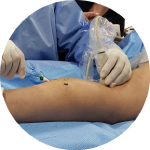
Endovenous stenting is associated with high patency, and low morbidity in the treatment of iliofemoral-caval occlusive venous disease. That said, recurrent stent occlusion presents a challenging problem.
Taimur Saleem, MD, gives a brief overview of treatment options for these occlusions during Recurrent Venous Stent Occlusion: Endovenectomy, Bypass, or Compression Only. The presentation, along with many other insightful expert sessions, is available on demand with a subscription to Vein Global.
Dr. Saleem explored three options in particular, especially in the case of inflow problems: endovenectomy, bypass and compression only.
In terms of open bypass, he said, Palma et al described a crossover femoro-femoral bypass using the contralateral great saphenous vein for patients with unilateral iliac vein obstruction. If there is no suitable GSV, an 8-mm ringed polytetrafluoroethylene (PTFE) graft can be used. To prevent bypass occlusion, he said, this operation is often combined with the creation of an arteriovenous (AV) fistula.
He showed a diagrammatic representation of the Palma bypass procedure. “The saphenous vein from the left side is transferred over to the right side, and that creates a crossover bypass,” he said. “And this is basically bypassing the occlusion on the external iliac of the right side.”
Dr. Saleem noted that open veno-venous procedures are major; that application has been limited by age or other comorbidities; and that the resulting scar, especially from the Palma procedure, can be a disadvantage. Reported patency has been variable, and symptoms may persist despite a patent Palma bypass, due to the restricted size of the saphenous conduit.
As for endovenectomy, Dr. Saleem discussed removal of the intraluminal trabeculations of the common femoral vein (CFV) and the orifice of the deep femoral vein (DFV) after longitudinal venotomy of the CFV. Closure of the incision is usually performed with a bovine patch, he said, and after the inflow into the common femoral vein is restored, angioplasty of the recanalized venous stent is performed. Complications such as wound infection, lymphorrhea, and wound dehiscence vary.
“At our center, we really have not had a very good experience with endovenectomy,” he said. “It seems to work if the trabeculations are few. And if you can extend the stent into the profunda, that may work well in some patients. More extensive trabeculations require extensive procedures with higher morbidity.” Dr. Saleem said his center has also tried removal of stents.
As venous disease “rarely is a threat to limb or life,” he said, compression is appropriate in most cases. “However, compliance remains a major issue.” It’s important, then, to do venous stenting right the first time. “Re-occlusions can be a very challenging problem to treat. Select patients appropriately for stenting.”
This session is available on demand, along with an entire library of procedure videos, subject-oriented presentations and case studies on superficial and deep venous education.
Recent Posts

Review of Radiofrequency Ablation Devices

Overtreatment in CVD Leads to Superficial Ablation Abuse

Ultrasound-guided Foam Sclerotherapy

Recurrent Stent Occlusion: Endovenectomy, Bypass, or Compression Only

Optimizing Deep Vein Images: The Profunda Femoris Vein

A Closer Look at Swollen Legs: Edema Differentiation

Vein Global and IVC are Evolving to Launch the Next Decade of Endovascular Innovation and Education

Phlebectomy: Technical Steps with Jose I. Almeida, MD, FACS, RPVI, RVT

The Spectrum of Vacuum-Assisted Venous Thrombectomy

Sclerotherapy: Technical Steps with Julian J. Javier, MD, FSCAI, FCCP

